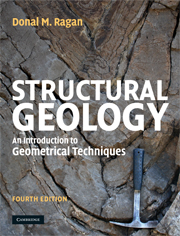Book contents
- Frontmatter
- Contents
- Preface
- Acknowledgements
- 1 Structural planes
- 2 Thickness and depth
- 3 Lines and intersecting planes
- 4 Planes and topography
- 5 Stereographic projection
- 6 Rotations
- 7 Vectors
- 8 Faults
- 9 Stress
- 10 Faulting
- 11 Deformation
- 12 Strain
- 13 Flow
- 14 Folds
- 15 Parallel folds
- 16 Similar folds
- 17 Folds and topography
- 18 Structural analysis
- 19 Tectonites
- 20 Drill hole data
- 21 Maps and cross sections
- 22 Block diagrams
- Appendices
- References
- Index
3 - Lines and intersecting planes
Published online by Cambridge University Press: 05 June 2012
- Frontmatter
- Contents
- Preface
- Acknowledgements
- 1 Structural planes
- 2 Thickness and depth
- 3 Lines and intersecting planes
- 4 Planes and topography
- 5 Stereographic projection
- 6 Rotations
- 7 Vectors
- 8 Faults
- 9 Stress
- 10 Faulting
- 11 Deformation
- 12 Strain
- 13 Flow
- 14 Folds
- 15 Parallel folds
- 16 Similar folds
- 17 Folds and topography
- 18 Structural analysis
- 19 Tectonites
- 20 Drill hole data
- 21 Maps and cross sections
- 22 Block diagrams
- Appendices
- References
- Index
Summary
Definitions
Line: the geometrical element generated by a moving point; it has only extension along the path of the point. Lines may be rectilinear (straight) or curvilinear (curved). Only straight lines are treated here.
Plunge: the vertical angle measured downward from the horizontal to a line (Fig. 3.1a).
Pitch: the angle between the strike direction and a line in a specified plane (Fig. 3.1b). Rake is synonymous.
Trend: the horizontal direction of the vertical plane containing the line, specified by its bearing or azimuth.
Linear structures
There are two types of structural lines. They may exist in their own right, such as the long axes of mineral grains or streaks of mineral aggregates; elongate rock bodies and drill holes may also be considered linear for some purposes. Other lines occur in conjunction with structural planes; examples include striations on fault surfaces, mineral lineation on foliation planes and lines formed by the intersection of planes.
The orientation of a line in space is specified by its trend and plunge. As with planes, there is a set of map symbols for structural lines, also with three parts.
A trend line.
An arrowhead giving the direction of downward inclination.
A plunge angle written near the arrowhead.
The arrow should be uniform in length and long enough so that its trend can be accurately measured on the map. Because its length is not scaled, this symbol is not a vector.
- Type
- Chapter
- Information
- Structural GeologyAn Introduction to Geometrical Techniques, pp. 57 - 71Publisher: Cambridge University PressPrint publication year: 2009



